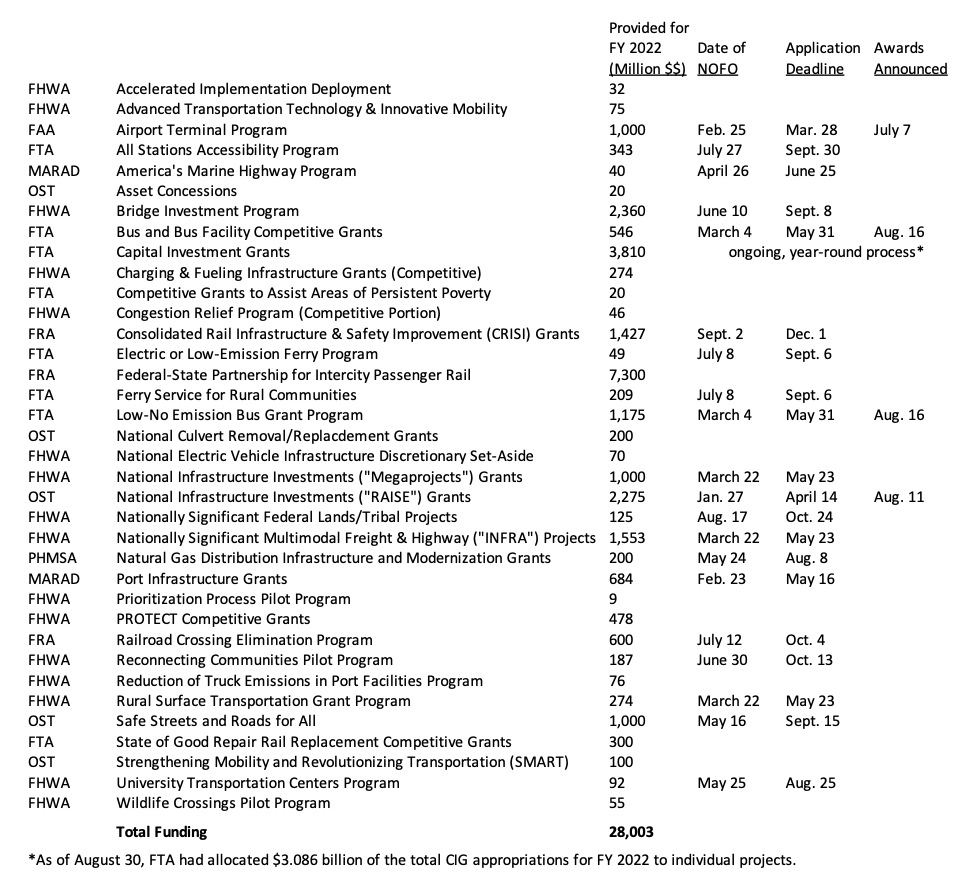Last year’s bipartisan infrastructure law (the Infrastructure Investment and Jobs Act, or IIJA) provided a significant boost in annual funding across many modes of infrastructure, and devoted a record share of that bounty to competitive grant programs.
For the first year of the IIJA (fiscal year 2022), the amount of competitive grant money available to the Secretary of Transportation from all sources (the IIJA, plus regular, annual DOT appropriations) totaled around $28 billion by our count. The comparative total for fiscal year 2021 was only around $5.5 billion, so the IIJA quintupled the amount of money the Secretary gets to give out every year.
How is DOT doing at getting that money to work?
ETW counted up all of the IIJA competitive programs we could think of at DOT, and came up with the $28 billion number. We then did a lot of internet searching and poking around the DOT website looking for funding announcements.
But first, one clarification. One of these competitive programs, a very large and prominent one, is not like any of the others.
The 2022 DOT Appropriations Act and the IIJA combine to provide $3.8 billion for the Federal Transit Administration’s Capital Investment Grant program. Unlike all of the other competitive grant programs, the CIG program has an ongoing, multi-year process of application for pre-funding evaluation and eventual approval of a federal project construction grant. As such, you can’t compare it with programs where each year’s funding is completely given out by its own application-evaluation-award cycle.
(As it happens, the latest disclosure on the FTA website indicates that as of now, FTA has allocated $3.086 billion of the $3.810 billion total 2022 appropriation to individual projects, meaning that 81 percent of that money is spoken for.)
Subtracting the CIG program from the rest gives a revised total of $24.9 billion in FY 2022 competitive grant funding that is subject to the usual “NOFO” process (Notice of Funding Opportunity).
Of that $24.9 billion, we estimate that as of yesterday, DOT has released NOFOs asking non-federal partners to apply for available funds totaling $15.1 billion, or 54 percent of the $24.9 billion available total.
DOT has announced the winning applications for a total of $5.0 billion worth of fiscal 2022 grant funding (18 percent of the available total), but we have always had a sneaking suspicion that DOT would do as much as humanly possible to get as many grants as possible announced before the fall midterm elections (every Administration does it), so that total is likely to rise in the next few weeks.
In particular, the combined NOFO for INFRA grants ($1.6 billion), the new “megaprojects” program ($1.0 billion), and the new rural grant program ($274 million) was closed to new applicants on May 23, so it seems like announcements on those programs are within the realm of possibility in the next few weeks. Likewise, applications for the $684 million seaport infrastructure program closed on May 16, so we could hear those announcements soon as well.
Some of the newer programs have taken longer to develop. The new program providing $2.4 billion per year for large, economically important bridges did not have a NOFO issued until June 10, and it does not close until this week (September 8), so pre-election grant announcements are probably unlikely.
The biggest area of delay is the IIJA emphasis on rail programs, which were given droopingly huge amounts of funding. That law provides $7.2 billion per year for grants for new and improved intercity passenger rail service (no NOFO yet), as well as a new $600 million per year grade crossing program (no NOFO yet) and a total of $1.4 billion for CRISI rail safety grants (NOFO issued last Friday).
Our first status report, which we hope to publish a few times a year, is below.




